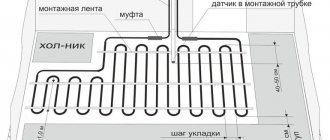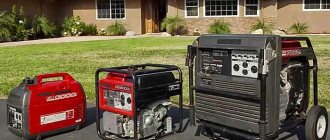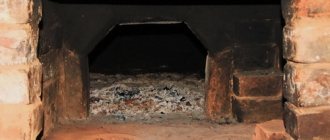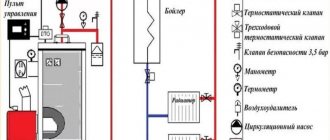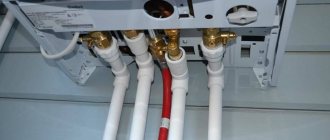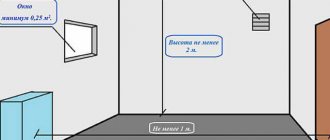The basis of any heating is a boiler. Whether the house will be warm depends on how correctly its parameters are selected. In order for the parameters to be correct, it is necessary to calculate the boiler power. These are not the most complex calculations - at the third grade level, you will only need a calculator and some data on your possessions. You can handle everything yourself, with your own hands.
There are several ways to calculate the power of a heating boiler
General points
In order for the house to be warm, the heating system must replenish all existing heat losses in full. Heat escapes through walls, windows, floors, and roofs. That is, when calculating the boiler power, it is necessary to take into account the degree of insulation of all these parts of the apartment or house. With a serious approach, they order a calculation of the building’s heat loss from specialists, and based on the results, they select the boiler and all other parameters of the heating system. This task is not to say that it is very difficult, but it is necessary to take into account what the walls, floor, ceiling are made of, their thickness and the degree of insulation. They also take into account the cost of windows and doors, whether there is a supply ventilation system and what its performance is. In general, a long process.
There is a second way to determine heat loss. You can actually determine the amount of heat that a house/room loses using a thermal imager. This is a small device that displays the actual picture of heat loss on the screen. At the same time, you can see where the outflow of heat is greater and take measures to eliminate leaks.
Determining actual heat loss - an easier way
Now let’s talk about whether it’s worth taking a boiler with a power reserve. In general, constant operation of equipment at the limit of its capabilities negatively affects its service life. Therefore, it is advisable to have a performance reserve. Small, about 15-20% of the calculated value. It is quite enough to ensure that the equipment does not work at the limit of its capabilities.
Too much stock is not economically profitable: the more powerful the equipment, the more expensive it is. Moreover, the price difference is significant. So, if you are not considering the possibility of increasing the heated area, you should not take a boiler with a large power reserve.
Why is there high gas consumption in the house?
High gas consumption from a home heater can have various reasons. It is known that a floor-standing unit is more wasteful. It is much inferior to wall-mounted options. In addition, the situation can be worsened by an incorrectly designed smoke removal system (for example, made of brick, ferrous metals or uninsulated stainless steel pipes). You can find out more about the places through which heat leaves the house using a special thermal imaging device.
Also read with this article: Checking gas equipment
Calculation of boiler power by area
This is the easiest way to select a heating boiler by power. When analyzing many ready-made calculations, an average figure was derived: heating 10 square meters of area requires 1 kW of heat. This pattern is valid for rooms with a ceiling height of 2.5-2.7 m and average insulation. If your house or apartment fits these parameters, knowing the area of your house, you can easily determine the approximate performance of the boiler.
Heat flows out of the house in different directions
To make it clearer, we give an example of calculating the power of a heating boiler by area. There is a one-story house 12*14 m. Find its area. To do this, multiply its length and width: 12 m * 14 m = 168 sq.m. According to the method, we divide the area by 10 and get the required number of kilowatts: 168 / 10 = 16.8 kW. For ease of use, the figure can be rounded: the required heating boiler power is 17 kW.
Taking ceiling heights into account
But in private homes, ceilings may be higher. If the difference is only 10-15 cm, it can be ignored, but if the ceiling height is more than 2.9 m, you will have to recalculate. To do this, find a correction factor (dividing the actual height by the standard 2.6 m) and multiply the found figure by it.
Example of correction for ceiling heights . The building's ceiling height is 3.2 meters. It is necessary to recalculate the power of the heating boiler for these conditions (the parameters of the house are the same as in the first example):
- We calculate the coefficient. 3.2 m / 2.6 m = 1.23.
- Let's correct the result: 17 kW * 1.23 = 20.91 kW.
- Rounding up, we get 21 kW required for heating.
When choosing a boiler based on power, do not forget that with increasing power, the size of the unit also increases
As you can see, the difference is quite significant. If you do not take it into account, there is no guarantee that the house will be warm even at average winter temperatures, let alone severe frosts.
Accounting for region of residence
Something else worth considering is the location. After all, it is clear that in the south much less heat is required than in the Middle Zone, and for those who live in the north, the “Moscow region” power will clearly be insufficient. There are also coefficients to take into account the region of residence. They are given with a certain range, since within one zone the climate still varies greatly. If the house is located closer to the southern border, a smaller coefficient is used, closer to the northern - a larger one. It is also worth considering the presence/absence of strong winds and choosing a coefficient taking them into account.
- Central Russia is taken as a standard. Here the coefficient is 1-1.1 (closer to the northern border of the region it is still worth increasing the boiler power).
- For Moscow and the Moscow region, the result obtained must be multiplied by 1.2 - 1.5.
- For northern regions, when calculating the boiler power by area, the found figure is multiplied by 1.5-2.0.
- For the southern part of the region, the reduction coefficients are: 0.7-0.9.
It is also necessary to take into account your region of residence
Example of adjustment by zones. Let the house for which we calculate the boiler power be located in the north of the Moscow region. Then the found figure of 21 kW is multiplied by 1.5. Total we get: 21 kW * 1.5 = 31.5 kW.
As you can see, when compared with the original figure obtained when calculating by area (17 kW), obtained as a result of using only two coefficients, it is significantly different. Almost twice. So these parameters need to be taken into account.
Double-circuit boiler power
Above we discussed calculating the power of a boiler that only works for heating. If you also plan to heat water, you need to increase the productivity even more. When calculating the power of a boiler with the ability to heat water for domestic needs, 20-25% of the reserve is included (must be multiplied by 1.2-1.25).
To avoid having to buy a very powerful boiler, you need to insulate the house as much as possible
Example: we adjust for the possibility of DHW. We multiply the found figure of 31.5 kW by 1.2 and get 37.8 kW. The difference is significant. Please note that the reserve for water heating is taken after the location is taken into account in the calculations - the water temperature also depends on the location.
How to set up a gas boiler for lower gas consumption
When the reasons for high gas consumption are identified, you can begin to eliminate them. There are several ways to solve the problem. Let's look at the most common of them.
Are you satisfied with gas consumption?
Normal consumption
14.29%
We need to reduce
85.71%
Voted: 14
Read more: Gas consumption per person per month
Reduce boiler power manually or automatically
When the boiler is operating at too high a power, you can simply reduce this indicator manually, but modern heaters make it possible to do this also in automatic mode.
If your heater has a simulated gas burner, the unit is likely set to a certain rated operating power that must be reduced to achieve positive fuel economy benefits. A room or radiator thermostat will help to automatically regulate the reduction in gas consumption - this will help reduce power as the air temperature rises.
Correctly design the ventilation and smoke removal system
Expert opinion
Tatyana Popova
Engineer, leading specialist in a gas supply organization with many years of experience
Ask a Question
An atmospheric floor or wall-mounted gas boiler is draft-dependent. Therefore, first of all, pay attention to the chimney and ventilation. It is desirable that the chimney pipe be made of stainless steel. Chimneys must be insulated. If the gas boiler suddenly begins to consume a large amount of fuel, check the heat exchanger for contamination and airiness in the system. Moreover, the gas boiler itself can drive air due to the boiler’s air vent not being completely closed.
You can reduce the gas consumption of a gas boiler by correcting errors in the construction of pipes that discharge combustion products. The chimney system, which is used to remove gas combustion products, as well as ventilation, must be organized correctly at the stage of installing the boiler in the house.
In order for these important engineering structures to work correctly, you should adhere to current sanitary standards and rules when arranging them.
We recommend the articles: How to properly make a chimney for a gas boiler and How to design ventilation
Eliminating the causes of chemical underburning
One of the reasons for high gas consumption is incomplete combustion of fuel, its chemical underburning. This occurs due to a lack of oxygen, which is so necessary to maintain the combustion process. It is worth checking the chimney for clogging - a significant amount of soot deposited on the walls of the pipes will interfere with normal combustion.
Blockage in the chimney
A poor smoke removal process also has a negative impact, because exhaust gases in this case take up space where clean air should be.
Eliminating the causes of mechanical underburning
Mechanical underburning of gas occurs due to too much boiler draft and incorrect setting of its operating power. It turns out that a too well-functioning smoke exhaust system can cause the rapid removal of unburned gas along with its combustion products. In this case, it will be enough to partially block the chimney.
Cleaning the heat exchanger and coolant
When a heating gas heater operates, water is the coolant. It constantly passes through the heat exchanger, providing heating to the premises of the house. If the exchanger along with the water becomes dirty, a layer of scale appears that needs to be removed. You can reduce gas consumption in the boiler by cleaning the heat exchanger. After cleaning this important part of the heating system, the heat transfer properties will be restored and the boiler will stop consuming gas so much.
Features of calculating boiler performance for apartments
Calculation of boiler power for heating apartments is calculated according to the same norm: 1 kW of heat per 10 square meters. But the correction is taking place according to other parameters. The first thing that needs to be taken into account is the presence or absence of an unheated room above and below.
- if there is another heated apartment below/above, a coefficient of 0.7 is applied;
- if the room below/at the top is unheated, we do not make any changes;
- heated basement/attic - coefficient 0.9.
When making calculations, it is also worth taking into account the number of walls facing the street. Corner apartments require more heat:
- if there is one external wall - 1.1;
- two walls face the street - 1.2;
- three external ones - 1.3.
You need to take into account the number of external walls
. These are the main areas through which heat escapes. It is imperative to take them into account. You can also take into account the quality of the windows. If these are double-glazed windows, adjustments need not be made. If there are old wooden windows, the found figure must be multiplied by 1.2.
You can also take into account factors such as the location of the apartment. In the same way, you need to increase the power if you want to buy a double-circuit boiler (for heating hot water).
Calculation by volume
In the case of determining the power of a heating boiler for an apartment, you can use another method, which is based on SNiP standards. They stipulate standards for heating buildings:
- heating one cubic meter in a panel house requires 41 W of heat;
- to compensate for heat loss in a brick building - 34 W.
To use this method, you need to know the total volume of the premises. In principle, this approach is more correct, since it immediately takes into account the height of the ceilings. A slight difficulty may arise here: usually we know the area of our apartment. The volume will have to be calculated. To do this, we multiply the total heated area by the height of the ceilings. We get the required volume.
Heating boiler calculations for apartments can be done according to standards
An example of calculating the power of a boiler for heating an apartment. Let the apartment be on the third floor of a five-story brick building. Its total area is 87 sq. m, ceiling height 2.8 m.
- Finding the volume. 87 * 2.7 = 234.9 cu. m.
- Round up - 235 cubic meters. m.
- We calculate the required power: 235 cubic meters. m * 34 W = 7990 W or 7.99 kW.
- Round up, we get 8 kW.
- Since there are heated apartments at the top and bottom, we apply a coefficient of 0.7. 8 kW * 0.7 = 5.6 kW.
- Round up: 6 kW.
- The boiler will also heat water for domestic needs. We will give a reserve of 25% for this. 6 kW * 1.25 = 7.5 kW.
- The windows in the apartment have not been replaced; they are old, wooden. Therefore, we use a multiplying factor of 1.2: 7.5 kW * 1.2 = 9 kW.
- Two walls in the apartment are external, so once again we multiply the found figure by 1.2: 9 kW * 1.2 = 10.8 kW.
- Round up: 11 kW.
In general, here is this technique for you. In principle, it can also be used to calculate the power of a boiler for a brick house. For other types of building materials, standards are not prescribed, and a panel private house is a rarity.
Coolant speed
Then, using the obtained coolant flow values, it is necessary for each section of pipes in front of the radiators to calculate the speed of water movement in the pipes using the formula:
,
where V is the coolant movement speed, m/s;
m is the coolant flow through the pipe section, kg/s
ρ—density of water, kg/cub.m. can be taken equal to 1000 kg/cub.m.
f - cross-sectional area of the pipe, sq.m. can be calculated using the formula: π * r2, where r is the internal diameter divided by 2
Coolant velocity calculator
m = l/s; pipe mm by mm; V = m/s
Requirements for the indicator
The main requirement for the main characteristics of the equipment is that its power corresponds to the optimal value for the apartment and the existing conditions. Deviation from it should be minimal. There are also additional requirements depending on the value of the calculated value:
- for devices with P < 30 kW, the required ceiling height is more than 2.2 m;
- for devices with P > 30 kW, the height of the premises is at least 2.5 m;
- for several units the distance between them and the wall is at least 1 m, for 1 device between its front part and the opposite wall is also at least 1 m;
- its upper part should be 0.7 m from the ceiling;
- the width of the door in a room with a heating device is at least 0.8 m;
- walls, doors, partitions in the boiler room must be fire-resistant and resistant to steam and gases;
- the area of the boiler room with any type of installation is at least 4 m² while maintaining visibility;
- the room must have separate exits to the outside to ensure the removal and supply of air from the street;
The volume of the boiler room directly depends on the power of the heating equipment:
- for P <= 30 kW – more than 7.5 m³;
- for P from 30 kW to 80 kW – up to 15 m³;
- for P from 80 kW to 200 kW – over 15 m³.
It is strictly not recommended to connect the equipment yourself.
The best solid fuel boilers 2021 - 2019
The heating system is one of the integral communications of the building. And here progress also does not stand still: every year manufacturers delight with new units.
To make a good choice, it is necessary to take into account that each solid fuel boiler is designed for a certain power and, accordingly, may have a limitation on the size of the heating area.
The efficiency of the device and the type of control also matter; for example, the presence of an automatic ignition function will significantly simplify operation.
We have compiled a rating of the best new products of 2021 - 2021. According to buyers, these particular solid fuel boilers have the best price-quality ratio, ease of operation and attractive appearance. They are the most in demand and have already proven themselves worthy. So, let's look at our top 10.
Combination boiler for medium-sized areas - up to 200 sq.m. This model from a domestic manufacturer opens our rating of the best boilers of 2021 - 2021. It is possible to install a burner (also not included in the package). Has high heat transfer. The coolant temperature is from 50 to 90 degrees. The product lights up quickly and maintains a good temperature for a long time.
Pros:
- There is a built-in heating element with a power of 9 kW.
- Wide range of fuels - from solid fuels to gas.
Minuses:
- You must purchase a pellet or gas burner yourself.
- A small hole for storing firewood.
A budget option with good power is an excellent choice for a small private house or cottage. The manufacturer recommends using wood and charcoal to operate this boiler. The removable damper ensures easy cleaning of the coolant.
Description of the parameter and factors influencing power
The correct choice of boiler should be based on accurate knowledge of the heat losses of the house. Excessive power will lead to excessive consumption of natural gas, and its lack can cause rapid equipment breakdown. Factors influencing the determination of the main indicator of a heating device:
- climate zone;
- heated area;
- DHW consumption;
- volume of living space;
- thermal conductivity of walls, ceilings;
- the presence of an attic, attic, basement;
- type and scheme of ventilation in the building.
Calculations without taking these parameters into account are approximate with a deviation in one direction or another by 50% or more.

